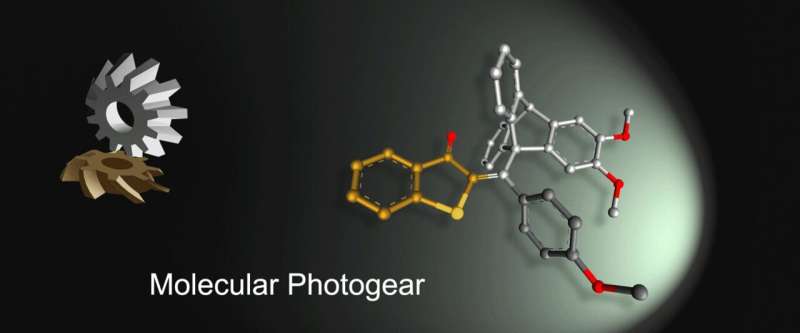Credit: Friedrich–Alexander University Erlangen–Nurnberg
Ever smaller and more intricate—without miniaturization, we wouldn't have the components today that are required for high-performance laptops, compact smartphones or high-resolution endoscopes. Research is now being carried out in the nanoscale on switches, rotors or motors that consist of only a few atoms in order to build what are known as molecular machines. A research team at FAU has successfully built the world's smallest energy powered gear wheel with a corresponding counterpart. The nano gear unit is the first that can also be actively controlled and driven. The researchers' findings have recently been published in the journal Nature Chemistry.
Miniaturization plays a key role in the further development of modern technologies and makes it possible to manufacture smaller devices that have more power. It also plays a significant role in manufacturing, since it allows functional materials and medication to be produced at previously unprecedented levels of precision. Now, research has entered the nanoscale—which is invisible to the naked eye—focusing on individual atoms and molecules. The significance of this new field of research is demonstrated by the Nobel Prize for Chemistry, which was awarded for research into molecular machines in 2016.
Some important components used in molecular machines such as switches, rotors, forceps, robot arms or even motors already exist in the nanoscale. A further essential component for any machine is the gear wheel, which allows changes in direction and speed and enables movements to be connected to each other. Molecular counterparts also exist for gear wheels, however, up to now, they have only moved passively back and forth, which is not extremely useful for a molecular machine.
The molecular gear wheel developed by the research team led by Prof. Dr. Henry Dube, Chair of Organic Chemistry I at FAU and previously head of a junior research group at LMU in Munich, measures only 1.6 nm. The research team has succeeded in actively powering a molecular gear wheel and its counterpart and has thus solved a fundamental problem in the construction of machines on the nanoscale.
The gear unit comprises two components that are interlocked with each other and are made up of only 71 atoms. One component is a triptycene molecule whose structure is similar to a propeller or bucket wheel. The second component is a flat fragment of a thioindigo molecule, similar to a small plate. If the plate rotates 180 degrees, the propeller rotates by only 120 degrees. The result is a 2:3 transmission ratio.
The nano gear unit is controlled by light, making it a molecular photogear. As they are directly driven by the light energy, the plate and the triptycene propeller move in locked synchronous rotation. Heat alone was not sufficient in order to make the gear unit rotate, as the FAU team discovered. When the researchers heated the solution around the gear unit in the dark, the propeller turned, but the plate did not—the gear "slipped". The researchers thus came to the conclusion that the nano gear unit can be activated and controlled using a light source.
More information: Aaron Gerwien et al, Photogearing as a concept for translation of precise motions at the nanoscale, Nature Chemistry (2022). DOI: 10.1038/s41557-022-00917-0
Journal information: Nature Chemistry
Provided by Friedrich–Alexander University Erlangen–Nurnberg
























